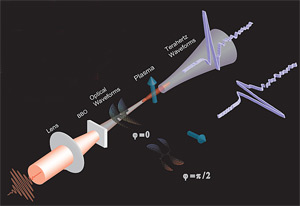
Handy Links
SLAC News Center
SLAC Today
- Subscribe
- Archives: Feb 2006-May 20, 2011
- Archives: May 23, 2011 and later
- Submit Feedback or Story Ideas
- About SLAC Today
SLAC News
Lab News
- Interactions
- Lightsources.org
- ILC NewsLine
- Int'l Science Grid This Week
- Fermilab Today
- Berkeley Lab News
- @brookhaven TODAY
- DOE Pulse
- CERN Courier
- DESY inForm
- US / LHC
SLAC Links
- Emergency
- Safety
- Policy Repository
- Site Entry Form

- Site Maps
- M & O Review
- Computing Status & Calendar
- SLAC Colloquium
- SLACspeak
- SLACspace
- SLAC Logo
- Café Menu
- Flea Market
- Web E-mail
- Marguerite Shuttle
- Discount Commuter Passes
-
Award Reporting Form
- SPIRES
- SciDoc
- Activity Groups
- Library
Stanford
Around the Bay
Researchers Achieve New Control of Useful Long-Wavelength Radiation
Physicists Aaron Lindenberg and Haidan Wen of the PULSE Institute for Ultrafast Energy Science have discovered a new mechanism for manipulating terahertz radiation fields, which are widely used in materials characterization, chemical sensing and noninvasive imaging. This work provides a new means for controlling the polarization of light at terahertz frequencies and represents a novel tool to help both reveal and direct ultrafast processes in materials. This work was published in Physical Review Letters on July 7.
"Our experiments have implications on both fundamental and applied research," Wen said. First, Wen said, the work helps researchers to understand the physics of generating terahertz radiation, making it possible to create more intense fields. Second, he said, the work provides a means to adjust terahertz polarization, which has not been possible before.
"This new research frontier known as plasma photonics has attracted great attention recently," Wen added. A similar result using a different experimental approach was reported by a research team from the Rensselaer Polytechnic Institute in the same issue of Physical Review Letters.
Terahertz radiation, characterized by long wavelength and low photon energy, lies at the opposite extreme of the electromagnetic spectrum with respect to X-rays. It has been used as a tool for characterizing materials for decades, but until recently scientists have not been able to generate terahertz radiation at intensities high enough to alter material properties.
Working at PULSE—a joint collaboration between SLAC National Accelerator Laboratory and Stanford University—Lindenberg and Wen mixed and focused ultrashort, red and blue laser pulses. The laser field was so intense that electrons in air molecules—mainly nitrogen and oxygen molecules—disassociated from their atoms and began to freely oscillate in the laser field, creating a plasma. The focused red and blue laser pulses drove the electrons in one coordinated direction, resulting in a very fast current flow that produced the intense terahertz radiation.
Next, Lindenberg and Wen discovered they could precisely manipulate the terahertz field by simply increasing or decreasing the time between pulses of red and blue light—by only hundreds of attoseconds. "It was a beautifully simple result," Lindenberg said. "We changed the time delay and saw the polarization state start spinning around." Because the terahertz polarization is extremely sensitive to the this timing, the new approach could enable construction of ultrafast terahertz switches and terahertz modulators, which could in turn lead to novel experimental and real-world applications.
The pulses of terahertz radiation Lindenberg and Wen created are so short that researchers can effectively hit a sample with a single, ultrafast spike of the electric field, like hitting a baseball with one swing of a bat, Wen said. In contrast, other sources of experimental radiation expose samples to multiple oscillating periods, like bouncing a ping-pong ball between two paddles. "The terahertz field generated in our lab is composed of only about one-half an oscillation cycle, and can thus transfer momentum to a charged particle effectively." Wen said. "Conventional lasers can't do that."
Combining the incredibly precise terahertz radiation techniques with hard X-ray techniques could paint a more complete picture than using them separately. For that, Lindenberg and Wen have their sights on an even more-intense terahertz source. SLAC's linear accelerator, which now drives the Linac Coherent Light Source, is capable of producing very intense terahertz fields. "These would be orders of magnitudes higher intensity than what we are producing in the laboratory now," Lindenberg said. This presents a great opportunity for exciting experiments using both terahertz radiation and the LCLS's ultrabright X-ray pulses.
After precisely "pumping" a sample with terahertz light, researchers could image the material with LCLS X-rays, effectively taking a super-fast time-lapse film of the material's reaction to the precisely directed terahertz field at the atomic level. "The new frontier is real-time," Lindenberg said.
—Lauren Knoche
SLAC Today, September 29, 2009
